Search results for: 'Control+pan'
- Related search terms
- control+pane
- control+panel
- control+panel'
- Control+pan'
- Control+pan''
-
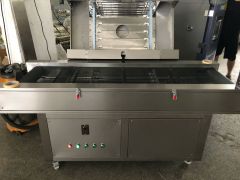 YY-1136 ULTRAVIOLET STERILIZERYY-1136 ULTRAVIOLET STERILIZER MAINTENANCE OF UV STERILIZER: 1 CHECK REGULARLY TO ENSURE THE NORMAL OPERATION OF THE UV LAMP. 2. AFTER 9000 HOURS OR ONE YEAR OF CONTINUOUS USE, THE ULTRAVIOLET LAMP SHOULD BE REPLACED. WHEN REPLACING A NEW LAMP, FIRST UNPLUG THE POWER SOCKET OF THE LAMP AND TAKE OUT THE ULTRAVIOLET LAMP. PAY ATTENTION NOT TO TOUCH THE QUARTZ GLASS OF THE NEW LAMP WITH YOUR FINGERS, BECAUSE THE STAIN WILL AFFECT THE INTENSITY OF THE LIGHT, AND CAREFULLY PUT THE LAMP INTO THE CHAMBER OF THE STERILIZER. Learn More
YY-1136 ULTRAVIOLET STERILIZERYY-1136 ULTRAVIOLET STERILIZER MAINTENANCE OF UV STERILIZER: 1 CHECK REGULARLY TO ENSURE THE NORMAL OPERATION OF THE UV LAMP. 2. AFTER 9000 HOURS OR ONE YEAR OF CONTINUOUS USE, THE ULTRAVIOLET LAMP SHOULD BE REPLACED. WHEN REPLACING A NEW LAMP, FIRST UNPLUG THE POWER SOCKET OF THE LAMP AND TAKE OUT THE ULTRAVIOLET LAMP. PAY ATTENTION NOT TO TOUCH THE QUARTZ GLASS OF THE NEW LAMP WITH YOUR FINGERS, BECAUSE THE STAIN WILL AFFECT THE INTENSITY OF THE LIGHT, AND CAREFULLY PUT THE LAMP INTO THE CHAMBER OF THE STERILIZER. Learn More -
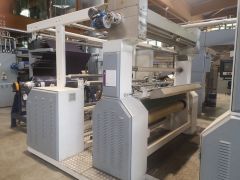 YY-1126 EASY MELT LAMINATING MACHINEYY-1126 EASY MELT LAMINATING MACHINE DETAILS: -TYPE EASY -YEAR 2013 -ROTOGRAVURE SYSTEM FOR COATING -3 ROLLERS ON THE MACHINE (ONE WORKING, TWO IN STAND-BY MODE) -INLET FROM ROLL -OUTLET WITH ROLL -CONTROL PANEL -NORDSON MELTING UNIT FOR PUR, YEAR 2015 Learn More
YY-1126 EASY MELT LAMINATING MACHINEYY-1126 EASY MELT LAMINATING MACHINE DETAILS: -TYPE EASY -YEAR 2013 -ROTOGRAVURE SYSTEM FOR COATING -3 ROLLERS ON THE MACHINE (ONE WORKING, TWO IN STAND-BY MODE) -INLET FROM ROLL -OUTLET WITH ROLL -CONTROL PANEL -NORDSON MELTING UNIT FOR PUR, YEAR 2015 Learn More -
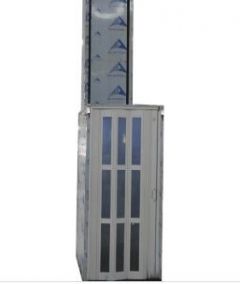 P-8867 HYDRAULIC WHEELCHAIR LIFTP-8867 HYDRAULIC WHEELCHAIR LIFT PRODUCT NAME: HYDRAULIC WHEELCHAIR LIFT CABIN SIZE: 1200X900MM DIMENSION SIZE: 1200X1000X4300MM LOAD CAPACITY: 250KG QUANTITY: 1 Learn More
P-8867 HYDRAULIC WHEELCHAIR LIFTP-8867 HYDRAULIC WHEELCHAIR LIFT PRODUCT NAME: HYDRAULIC WHEELCHAIR LIFT CABIN SIZE: 1200X900MM DIMENSION SIZE: 1200X1000X4300MM LOAD CAPACITY: 250KG QUANTITY: 1 Learn More -
 DORNIER HTVS8/J-200 RAPIER LOOM, YEAR 1994, JACQUARD, WORKING WIDTH 2000mmREFERENCE NUMBER: T-6858 DORNIER HTVS8/J-200 RAPIER LOOM, YEAR 1994, JACQUARD, WORKING WIDTH 2000mm DORNIER RAPIER LOOM TYPE HTVS8/J-200 YEAR OF CONSTRUCTION 1994 NOMINAL WORKING WIDTH 2000mm ELECTRONIC JACQUARD STAUBLI TYPE CX 960 YEAR OF CONSTRUCTION 1994 FORMAT 3072 WITH 2400 HOOKS INSTALLED 8 WEFT COLORS 4 WEFT FEEDERS IRO LASER ON SUPPORT BOBBIN CREEL ELECTRONIC LET-OFF AND TAKE-UP MOTOR GROB WARP DETECTION 4800 DROPPERS 1 WARP BEAM DISPLAY PANEL AT1 TAKE-UP SYSTEM OF THE WASTE SELVEDGE WASTE DUSTBIN BATCHING MOTION PBM CARDAN AXE JC4 CONTROLLER IN EXCELLENT CONDITION QUANTITY: 1 Learn More
DORNIER HTVS8/J-200 RAPIER LOOM, YEAR 1994, JACQUARD, WORKING WIDTH 2000mmREFERENCE NUMBER: T-6858 DORNIER HTVS8/J-200 RAPIER LOOM, YEAR 1994, JACQUARD, WORKING WIDTH 2000mm DORNIER RAPIER LOOM TYPE HTVS8/J-200 YEAR OF CONSTRUCTION 1994 NOMINAL WORKING WIDTH 2000mm ELECTRONIC JACQUARD STAUBLI TYPE CX 960 YEAR OF CONSTRUCTION 1994 FORMAT 3072 WITH 2400 HOOKS INSTALLED 8 WEFT COLORS 4 WEFT FEEDERS IRO LASER ON SUPPORT BOBBIN CREEL ELECTRONIC LET-OFF AND TAKE-UP MOTOR GROB WARP DETECTION 4800 DROPPERS 1 WARP BEAM DISPLAY PANEL AT1 TAKE-UP SYSTEM OF THE WASTE SELVEDGE WASTE DUSTBIN BATCHING MOTION PBM CARDAN AXE JC4 CONTROLLER IN EXCELLENT CONDITION QUANTITY: 1 Learn More -
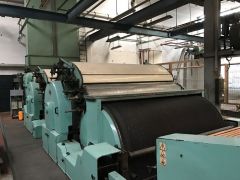 AUTEFA, DILO, SPINNBAU COMPLETE NONWOVEN LINEREFERENCE NUMBER: T-6855 AUTEFA, DILO, SPINNBAU COMPLETE NONWOVEN LINE BRAND: AUTEFA, DILO, SPINNBAU SHORT DESCRIPTION: COMPLETE NONWOVEN LINE ITEM 001 SINGLE DOFFER CARD BY “BESSI” - ITALY YEAR 1966 - WORKING WIDTH 2500mm - HOPPER-FEEDER WITH SCALE (WEIGHPAN) AND TOP SILO - INLET UNIT WITH ROLLERS - BREAST UNIT DIAMETER 1500mm WITH 3 PAIRS WORKERS/ STRIPPER (ORIGINALLY EQUIPPED WITH 5 PAIRS, UNUSED 2 PAIRS STILL AVAILABLE) - FANCY ROLL - TRANSPORT ROLL DIAMETER 1200mm - SWIFT DIAMETER 1500mm WITH 3 PAIRS WORKERS/ STRIPPER (ORIGINALLY EQUIPPED WITH 5 PAIRS, UNUSED 2 PAIRS STILL AVAILABLE) - DOFFER DIAMETER 1500mm WITH FLY-COMB - FLEXIBLE AND RIGID METALLIC WIRES IN EXCELLENT CONDITIONS QUANTITY: 1 ITEM 002 CROSS-LAPPER BY “MAK-AUTEFA” - GERMANY MODEL 101-42 YEAR 1965 - INLET WORKING WIDTH 2500mm - EXIT WORKING WIDTH 3000mm QUANTITY: 1 ITEM 003 PRE-NEEDLER BY “DILO” - GERMANY MODEL NFZ 3000 YEAR 1967 - WORKING WIDTH 3000mm - 2 NEEDLE BOARDS WITH TOTALLY 3000 NEEDLES / LIN MT - WITH BATT INLET UNIT QUANTITY: 1 ITEM 004 FINISH NEEDLERS BY “DILO” MODEL OD II 25 YEAR 1979 EACH - WORKING WIDTH 2500mm EACH - EACH ONE WITH 2 NEEDLE BOARDS WITH TOTALLY 5000 NEEDLES / LIN MT QUANTITY: 2 ITEM 005 TRANSVERSAL CUTTER BY “SPINNBAU-AUTEFA” - GERMANY. YEAR 1973 - WORKING WIDTH 2500mm QUANTITY: 1 ITEM 006 LONGITUDINAL CUTTER ITALIAN MAKE + ROLL WINDER ITALIAN MAKE ON ELECTRONIC WEIGHTING CELLS. WORKING WIDTH 2500mm QUANTITY: 1 ITEM 007 ROLLS LIFTING CRANE QUANTITY: 1 ALL ELECTRIC MOTORS AND CONTROL PANELS 400 V / 50 Hz Learn More
AUTEFA, DILO, SPINNBAU COMPLETE NONWOVEN LINEREFERENCE NUMBER: T-6855 AUTEFA, DILO, SPINNBAU COMPLETE NONWOVEN LINE BRAND: AUTEFA, DILO, SPINNBAU SHORT DESCRIPTION: COMPLETE NONWOVEN LINE ITEM 001 SINGLE DOFFER CARD BY “BESSI” - ITALY YEAR 1966 - WORKING WIDTH 2500mm - HOPPER-FEEDER WITH SCALE (WEIGHPAN) AND TOP SILO - INLET UNIT WITH ROLLERS - BREAST UNIT DIAMETER 1500mm WITH 3 PAIRS WORKERS/ STRIPPER (ORIGINALLY EQUIPPED WITH 5 PAIRS, UNUSED 2 PAIRS STILL AVAILABLE) - FANCY ROLL - TRANSPORT ROLL DIAMETER 1200mm - SWIFT DIAMETER 1500mm WITH 3 PAIRS WORKERS/ STRIPPER (ORIGINALLY EQUIPPED WITH 5 PAIRS, UNUSED 2 PAIRS STILL AVAILABLE) - DOFFER DIAMETER 1500mm WITH FLY-COMB - FLEXIBLE AND RIGID METALLIC WIRES IN EXCELLENT CONDITIONS QUANTITY: 1 ITEM 002 CROSS-LAPPER BY “MAK-AUTEFA” - GERMANY MODEL 101-42 YEAR 1965 - INLET WORKING WIDTH 2500mm - EXIT WORKING WIDTH 3000mm QUANTITY: 1 ITEM 003 PRE-NEEDLER BY “DILO” - GERMANY MODEL NFZ 3000 YEAR 1967 - WORKING WIDTH 3000mm - 2 NEEDLE BOARDS WITH TOTALLY 3000 NEEDLES / LIN MT - WITH BATT INLET UNIT QUANTITY: 1 ITEM 004 FINISH NEEDLERS BY “DILO” MODEL OD II 25 YEAR 1979 EACH - WORKING WIDTH 2500mm EACH - EACH ONE WITH 2 NEEDLE BOARDS WITH TOTALLY 5000 NEEDLES / LIN MT QUANTITY: 2 ITEM 005 TRANSVERSAL CUTTER BY “SPINNBAU-AUTEFA” - GERMANY. YEAR 1973 - WORKING WIDTH 2500mm QUANTITY: 1 ITEM 006 LONGITUDINAL CUTTER ITALIAN MAKE + ROLL WINDER ITALIAN MAKE ON ELECTRONIC WEIGHTING CELLS. WORKING WIDTH 2500mm QUANTITY: 1 ITEM 007 ROLLS LIFTING CRANE QUANTITY: 1 ALL ELECTRIC MOTORS AND CONTROL PANELS 400 V / 50 Hz Learn More -
 T-6550 MEDICAL PROTECTIVE CLOTHING BLOOD SYNTHETIC PENETRABILITY TESTER
T-6550 MEDICAL PROTECTIVE CLOTHING BLOOD SYNTHETIC PENETRABILITY TESTERREFERENCE NUMBER: T-6550
MEDICAL PROTECTIVE CLOTHING BLOOD SYNTHETIC PENETRABILITY TESTER
TECHNICAL SPECIFICATIONS AND CONFIGURATION:
1. THE INSTRUMENT ADOPTS AN AIR SOURCE THAT CAN PROVIDE (0.5 ~ 30±0.1) KPA PRESSURE TO CONTINUOUSLY PRESSURIZED THE SAMPLE, WHICH IS NOT RESTRICTED BY THE SPACE OF THE TEST SITE;
2. THE AIR PRESSURE RANGE CAN BE ADJUSTED FREELY, AND THE ADJUSTMENT RANGE (0.5 ~ 30) KPA;
3. COLOR TOUCH SCREEN DISPLAY AND OPERATION;
4. THE SAMPLE CLAMPING PAD IS PROCESSED WITH IMPORTED SPECIAL ALUMINUM PROFILES, WHICH IS LIGHT IN MATERIAL, CLEAN IN SURFACE AND NEVER RUSTS.
5. THE INSTRUMENT ADOPTS IMPORTED SPECIAL ALUMINUM WIRE DRAWING PANEL, EQUIPPED WITH METAL KEYS, SENSITIVE OPERATION, NOT EASY TO DAMAGE;
6. CLAMPING DEVICE FOR INSTRUMENT SAMPLES, EQUIPPED WITH LOCKING PROTECTION, TO PREVENT THE SYNTHETIC BLOOD FROM SPLASHING AROUND;
7. CLAMPING FORCE IS ACCURATE AND RELIABLE;
8. THE TEST TANK IS EQUIPPED WITH A SPECIAL PLACEMENT DEVICE, WHICH IS CONVENIENT FOR CUSTOMERS TO OPERATE;
9. THE TEST TANK IS PROCESSED WITH SPECIAL 316 STAINLESS STEEL, AND THE TOP IS EQUIPPED WITH A SPECIAL COVER FOR HIGH TRANSPARENT PROTECTION;
10. THE WASHER BELOW THE SAMPLE IS MADE OF HIGH-QUALITY PTFE MATERIAL AFTER SPECIAL PROCESSING;
11. SQUARE METAL BLOCK NET: OPEN SPACE ≥50°%; BENDING ≤5mm AT 30KPA;
12. INSTRUMENT TIME CONTROL ACCURACY ≤01 SECONDS;
13. THE SHELL OF THE INSTRUMENT IS MADE OF HIGH-QUALITY METAL BAKING PAINT, WHICH IS BEAUTIFUL AND GENEROUS.
14. EQUIPPED WITH PRINTER INTERFACE, CONNECTED TO THE PRINTER CAN DIRECTLY PRINT DATA REPORTS.
TECHNICAL PARAMETERS:
1. SAMPLE SIZE: 75mm X 75mm
2. TEST AREA: 28.26 SQUARE CENTIMETERS
3. AIR PRESSURE ADJUSTMENT RANGE (0.5 ~ 30) KPA
4. EXTERNAL SIZE: 500mm X 500mm X 500mm (L X W X H)
5. WEIGHT OF THE INSTRUMENT: 40 KG
6. POWER SUPPLY: AC220V, 50HZ,SCOPE OF SUPPLY: 1. ONE MAIN MACHINE; 2. TWO PTFE GASKETS; 3. TWO ORDINARY WASHERS; 4. ONE METAL BLOCKING NET; 5. A SET OF SPECIAL LOCKING TOOLS; 6. ONE HIGH-QUALITY SILENT AIR PUMP, [NOTE: SAFETY PRODUCTION LICENSE IS NOT INCLUDED]. 7. EQUIPPED WITH PRINTER INTERFACE; 8. ONE SAMPLE TEMPLATE; 9. ONE PRODUCT CERTIFICATE; 10. ONE COPY OF PRODUCT OPERATION MANUAL.
OPERATION INSTRUCTION:
INSERT THE AIR PUMP OUTPUT PIPE INTO THE OIL AND WATER SEPARATOR OF THE INSTRUMENT AS REQUIRED (PRESSURE 0.1-0.3MPA).
AFTER SWITCHING ON THE POWER, THE STARTUP INTERFACE (NAME OF THE DEVICE) IS DISPLAYED.
PRESS THE "ENTER" BUTTON TO ENTER THE TEST INTERFACE, AS SHOWN IN THE FOLLOWING FIGURE:
CLICK "SETTING” BUTTON, GET INTO PARAMETER SETTING SCREEN, AS BELOW THIS SCREEN CAN SET THE SYSTEM TIME, DATE AND TESTING TIME, AFTER SETTING, CLICK "SAVE” BUTTON TO KEEP THE SETTING DATA. (NOTE: IT REQUIRES 5 MINUTES IN THE STANDARD)
QUANTITY: 1
Learn More -
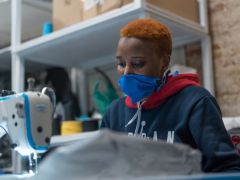 D-2388 What’s the Best Material for a Mask?
D-2388 What’s the Best Material for a Mask?Federal health officials have now recommended that we cover our faces with fabric during the coronavirus pandemic. But what material offers the most protection?
The Centers for Disease Control and Prevention has posted a no-sew mask pattern using a bandanna and a coffee filter as well as a video on making masks using rubber bands and folded fabrics found at home.
While a simple face covering can reduce the spread of coronavirus by blocking outgoing germs from coughs or sneezes of an infected person, experts say there is more variation in how much homemade masks might protect the wearer from incoming germs, depending on the fit and quality of the material used.
Scientists around the country have taken it upon themselves to identify everyday materials that do a better job of filtering microscopic particles. In recent tests, HEPA furnace filters scored well, as did vacuum cleaner bags, layers of 600-count pillowcases and fabric similar to flannel pajamas. Stacked coffee filters had medium scores. Scarves and bandanna material had the lowest scores, but still captured a small percentage of particles.
If you don’t have any of the materials that were tested, a simple light test can help you decide whether a fabric is a good candidate for a mask.
“Hold it up to a bright light,” said Dr. Scott Segal, chairman of anesthesiology at Wake Forest Baptist Health who recently studied homemade masks. “If light passes really easily through the fibers and you can almost see the fibers, it’s not a good fabric. If it’s a denser weave of thicker material and light doesn’t pass through it as much, that’s the material you want to use.”
Researchers say it’s important to remember that lab studies are conducted under perfect conditions with no leaks or gaps in the mask, but the test methods give us a way to compare materials. And while the degree of filtration for some homemade masks seems low, most of us — who are staying home and practicing social distancing in public — don’t need the high level of protection required for medical workers. More important, any face covering is better than none, especially if worn by a person who has the virus but doesn’t know it.
The biggest challenge of choosing a homemade mask material is to find a fabric that is dense enough to capture viral particles, but breathable enough that we can actually wear it. Some items being touted online promise high filtration scores, but the material would be unwearable.
Dressing Up for Work … at Home
Yang Wang, an assistant professor of environmental engineering at Missouri University of Science and Technology, worked with his graduate students to study various combinations of layered materials — including both air filters and fabric. “You need something that is efficient for removing particles, but you also need to breathe,” said Dr. Wang, who last fall won an international award for aerosol research.To test everyday materials, scientists are using methods similar to those used to test medical masks, which everybody agrees should be saved for medical workers who are exposed to high doses of virus from seeing infected patients. The best medical mask — called the N95 respirator — filters out at least 95 percent of particles as small as 0.3 microns. By comparison, a typical surgical mask — made using a rectangular piece of pleated fabric with elastic ear loops — has a filtration efficiency ranging from 60 to 80 percent.
Dr. Wang’s group tested two types of air filters. An allergy-reduction HVAC filter worked the best, capturing 89 percent of particles with one layer and 94 percent with two layers. A furnace filter captured 75 percent with two layers, but required six layers to achieve 95 percent. To find a filter similar to those tested, look for a minimum efficiency reporting value (MERV) rating of 12 or higher or a microparticle performance rating of 1900 or higher.
The problem with air filters is that they potentially could shed small fibers that would be risky to inhale. So if you want to use a filter, you need to sandwich the filter between two layers of cotton fabric. Dr. Wang said one of his grad students made his own mask by following the instructions in the C.D.C. video, but adding several layers of filter material inside a bandanna.
Dr. Wang’s group also found that when certain common fabrics were used, two layers offered far less protection than four layers. A 600 thread count pillow case captured just 22 percent of particles when doubled, but four layers captured nearly 60 percent. A thick woolen yarn scarf filtered 21 percent of particles in two layers, and 48.8 percent in four layers. A 100 percent cotton bandanna did the worst, capturing only 18.2 percent when doubled, and just 19.5 percent in four layers.
The group also tested Brew Rite and Natural Brew basket-style coffee filters, which, when stacked in three layers, showed 40 to 50 percent filtration efficiency — but they were less breathable than other options.
If you are lucky enough to know a quilter, ask them to make you a mask. Tests performed at the Wake Forest Institute for Regenerative Medicine in Winston-Salem, N.C., showed good results for homemade masks using quilting fabric. Dr. Segal, of Wake Forest Baptist Health, who led the study, noted that quilters tend to use high-quality, high-thread count cotton. The best homemade masks in his study were as good as surgical masks or slightly better, testing in the range of 70 to 79 percent filtration. Homemade masks that used flimsier fabric tested as low as 1 percent filtration, Dr. Segal said.
The best-performing designs were a mask constructed of two layers of high-quality, heavyweight “quilter’s cotton,” a two-layer mask made with thick batik fabric, and a double-layer mask with an inner layer of flannel and outer layer of cotton.
Bonnie Browning, executive show director for the American Quilter’s Society, said that quilters prefer tightly woven cottons and batik fabrics that stand up over time. Ms. Browning said most sewing machines can handle only two layers of fabric when making a pleated mask, but someone who wanted four layers of protection could wear two masks at a time.
Ms. Browning said she recently reached out to quilters on Facebook and heard from 71 people who have made a combined total of nearly 15,000 masks. “We quilters are very much in the thick of what’s going on with this,” said Ms. Browning, who lives in Paducah, Ky. “One thing most of us have is a stash of fabric.”
People who don’t sew could try a folded origami mask, created by Jiangmei Wu, assistant professor of interior design at Indiana University. Ms. Wu, who is known for her breathtaking folded artwork, said she began designing a folded mask out of a medical and building material called Tyvek, as well as vacuum bags, after her brother in Hong Kong, where mask wearing is common, suggested it. (DuPont, the maker of Tyvek, said in a statement that Tyvek is intended for medical apparel, not masks.) The folded mask pattern is free online, as is a video demonstrating the folding process. In tests at Missouri University and University of Virginia, scientists found that vacuum bags removed between 60 percent and 87 percent of particles. But some brands of vacuum bags may contain fiberglass or are harder to breathe through than other materials, and shouldn’t be used. Ms. Wu used a bag by EnviroCare Technologies, which has said it does not use fiberglass in its paper and synthetic cloth bags.
“I wanted to create an alternative for people who don’t sew,” said Ms. Wu, who said she is talking to various groups to find other materials that will be effective in a folded mask. “Given the shortage of all kinds of materials, even vacuum bags might run out.”
The scientists who conducted the tests used a standard of 0.3 microns because that is the measure used by the National Institute for Occupational Safety and Health for medical masks.
Linsey Marr, a Virginia Tech aerosol scientist and an expert in the transmission of viruses, said the certification method for respirators and HEPA filters focuses on 0.3 microns because particles around that size are the hardest to catch. While it seems counterintuitive, particles smaller than 0.1 microns are actually easier to catch because they have a lot of random motion that makes them bump into the filter fibers, she said.
“Even though coronavirus is around 0.1 microns, it floats around in a wide range of sizes, from around 0.2 to several hundred microns, because people shed the virus in respiratory fluid droplets that also contain lots of salts and proteins and other things,” said Dr. Marr. “Even if the water in the droplets fully evaporates, there’s still a lot of salt and proteins and other gunk that stays behind as solid or gel-like material. I think 0.3 microns is still useful for guidance because the minimum filtration efficiency will be somewhere around this size, and it’s what NIOSH uses.”
Learn More -
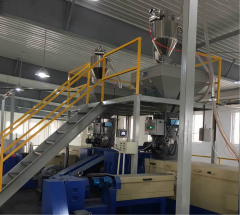 L-7134 PP NONWOVEN FABRIC PRODUCTION LINE, SPUNBONDED, MELT BLOWN
L-7134 PP NONWOVEN FABRIC PRODUCTION LINE, SPUNBONDED, MELT BLOWNEFFECTIVE WIDTH: 1600mm
DAILY OUTPUT: 10,000 KGS PER DAY
WEIGHT RANGE: 10 TO 150 GSM
FILAMENT DIAMETER: 1.6 TO 2.0 DENIER
SPEED: 350 TO 400 METERS PER MINUTE
RAW MATERIAL: POLYPROPYLENE (PP)
DIMENSIONS: 35,000 X 15,000 X 11,000mm
VOLTAGE: 380 VOLTS, 3 PHASECONSISTING OF:
SPUNBOND EQUIPMENT
PP VACUUM SUCTION MACHINE (2)
7800 TO 900 KGS PER HOUR
AIR CAPACITY: 300 CUBIC METERS PER HOUR
POWER: 7.5 KWMASTER BATCH DOSING UNIT (2)
ACCURACY: 0.01%EXTRUDER (2)
DIAMETER: 130mm
SINGLE SCREW (2)
HEATING SYSTEM: ELECTRICITY
MOTOR: 75 KWMELT FILTRATION MACHINE (2)
PIPE SIZE: 50mm
FILTER AREA: 3.5 SQUARE METERS
MELT FLOW: 650 KGS PER HOUR
DOUBLE FILTRATION CHAMBERMELTING PUMP (2)
40 RPM
FLOW CAPACITY: 400 KGS PER HOUR
POWER: 7.5 KWSPINNING BEAM (2)
DIMENSIONS: 1900 X 256mm
HANGER TYPE MELT DISTRIBUTION
HEATING SYSTEM: OIL
WORKING TEMPERATURE: 200 TO 260 CELSIUSSPINNERET (4)
HARDNESS: 30
SIZE: 1900mm LONG X 256mm WIDE
HOLE DIAMETER 0.45mm
HOLE QUANTITY: 6500 HOLE PER METERQUENCHING UNIT (2)
WORKING TEMP: 20 CELSIUS
AIR FLOW CAPACITY: 12,000 CUBIC METERS/H
AIR PRESSURE: 6500
FILTER SIZE: 80#FILAMENT DRAFT UNITS (2)
AIR PRESSURE: 5020PA
AIR FLOW CAPACITY: 12,000 CUBIC METERS/H
INSIDE TEMP: 10 TO 25 CELSIUS
FILAMENT FINENESS: 1.6 TO 2.0 DENIERMELT BLOWN EQUIPMENT
VACUUM SUCTION MACHINE (2)
LOAD CAPACITY: 700 TO 900 KGS PER HOUR
AIR CAPACITY: 300 CUBIC METERS/H
POWER: 7.5 KWMASTER BATCH DOSING UNIT (2)
4 HOPPERS
200 KGS HOPPER LOADEXTRUDER
DIAMETER: 105mm
SINGLE SCREW
MOTOR: 18.5 KWMELT FILTER
DOUBLE CYLINDER
HYDRAULIC
MELT FLOW CAPACITY: 450 KGS/HR
FILTER SIZE: 150mm DIAMETER
ELECTRIC HEATINGMELTING PUMP
SPEED: 40 RPM
MELT FLOW CAPACITY: 450 KGS PER HOUR
POWER: 7.5 KWMELT BLOWN DIE SPINNARET
SPINNERET HOLE SIZE: 0.32 TO 0.35mm
HOLE DISTANCE: 40 TO 42 PER INCH
FABRIC WEIGHT: 2 TO 200 GSMHIGH PRESSURE AIR BLOWER
AIR FLOW CAPACITY: 70 TO 100 CUBIC METERS PER MINUTE
AIR PRESSURE: 100 KPA
POWER: 200 KWWEB FORMING MACHINE
SPEED: 100 METERS PER MINUTEELECTRIC TREATMENT
VOLTAGE: 220 VOLTS, 50 Hz
INPUT CURRENT: 3A
OUTPUT VOLTAGE: 60 KV
TREAT WEB WIDTH: 1.6 METERSHOT AIR HEATING MACHINE
WORKING TEMP: 350 CELSIUS
PRESSURE: 0.8 KPA
HEATING: ELECTRIC
POWER: 200 KWTHERMAL CALENDER
PROCESSING SPEED: 400 METERS PER MINUTE
ROLLER SIZE: 2000mm LONG, 520mm DIAMETER
EMBOSSING ROLLER: 1
LINEAR PRESSURE: 30 TO 125 N/mm
HEATING SYSTEM: OILHYDROPHILIC MACHINE
SPEED: 400 METERS PER MINUTE
FEEDING SYSTEM: DOUBLE KISSING ROLLER
KISS ROLLER DIAMETER: 215mm
LIQUID TANK: 200 KGS WITH HEAT/WARM AND MIXDRYING SYSTEM:
INFRARED + HOT AIR
DRIVE ROLL SIZE: 150mm
HEATING EQUIPMENT: QUARTZ HEATER, HOT AIR BLOWER, EXHAUST AIR BLOWERINSPECTION MACHINE
EFFECTIVE WIDTH: 1600mm
INSPECTION SPEED: 400 METERS PER MINUTE
INSPECT GSM: 10 TO 40 GSMAUTOMATIC WINDING MACHINE
SPEED: 400 METERS PER MINUTE
ROLLER DIAMETER: 2000mm
ROLLER EXCHANGE SYSTEM: AUTOMATIC
FABRIC INSPECTOR: ONLINE
POWER: 15 KWHIGH SPEED SLITTING MACHINE
PROCESS SPEED: 800 METERS PER MIN
ROLL DIAMETER: MAX 1500mm
SLITTING WIDTH: 80mm
PAPER TUBE SIZE: 76mm DIAMETER
AUTO TENSILE CONTROL: AVAILABLE ONLINE
METER COUNTING: AVAILABLE ONLINEOIL HEATER (4)
HEATING POWER: 60 KW
MOTOR POWER: 7.5 KW
OIL PUMP FLOW: 30 CUBIC METERS PER SECOND
PRESSURE: 0.4 KPAWATER CHILLER
DRIVE SYSTEM: SCREW
COOLING CAPACITY: 300,000 CALORIES
TEMP: 0 TO 20 CELSIUS
POWER: 110 KWAIR BLOWER
SPEED: 1450 RPM
AIR BLOW CAPACITY: 12,000 CUBIC METERS PER HOUR
PRESSURE: 5200 PA
POWER: 30 KW x 3, 45 KW x 1AIR COMPRESSOR
DRIVE SYSTEM: SCREW
PRESSURE: 0.8 KPA
POWER: 15 KWHEATING SYSTEM: ELECTRIC
TEMP: 350 CELSIUS
HEATING TIME: 6 TO 8 HOURS
POWER: 4 KWULTRASONIC CLEANING MACHINE
3mm THICK
SIZE: 2000 X 500mm
FREQUENCY VIBRATION: 100 KHZ
TEMP: 40 CELSIUSELECTRONIC PANEL BOARD
PLATFORM
Learn More -
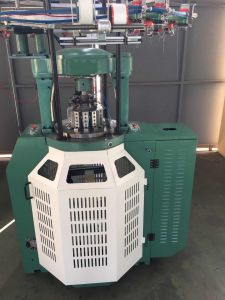 H-2413 RIB CIRCULAR KNITTING MACHINE 5”
H-2413 RIB CIRCULAR KNITTING MACHINE 5”CYLINDER DIAMETER: 5”
NO. OF FEEDERS: 10
130 NEEDLESGOLDEN ROC NEEDLE
DIAL 43.50 NEEDLE 2 TYPES
CYLINDER 122.48
NEEDLE 2 TYPES
NEEDLE DETECTOR: 6 PCS
DIGITAL CONTROL PANEL
CAM: 1 SET (MADE OF ALLOY STEEL, JAPAN)
CYLINDER 2 TRACKS, DIAL 2 TRACKS
TOTAL CAMS: 40 PCS
PNEUMATIC OIL LUBRICATOR
SMG POSITIVE STORAGE FEEDER
YARN FEEDING TOOTHED BELT
CYLINDER (MADE OF ALLOY STEEL, JAPAN)
INVERTER
LYCRA FEEDER
MOTOR
CREEL HOLDERS
FABRIC ROLLING MACHINESPARE PARTS:
CAM × 1 PC/TYPE
TOOLBOX (WITH TOOLS INSIDE) × 1 PC
NEEDLE DETECTOR × 2 PCS
NEEDLE × 100 PCS
YARN CARRIER × 2 PCS
POSITIVE STORAGE FEEDER × 2 PCSSHIPPING DIMENSIONS (WOODEN CASE): LENGTH 1600mm, WIDTH 1100mm, HEIGHT 2200mm 3.87 CBM
GROSS WEIGHT: 550 KGSQUANTITY: 1
Learn More -
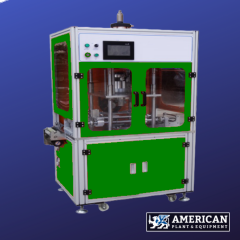 V-1816 AUTOMATIC RESPIRATOR REPLACEMENT FILTER MAKING MACHINE
V-1816 AUTOMATIC RESPIRATOR REPLACEMENT FILTER MAKING MACHINEAUTOMATIC RESPIRATOR REPLACEMENT FILTER MAKING MACHINE IS ALSO CALLED A PARTICULATE RESPIRATOR FILTER MAKING MACHINE OR HALF FACE RESPIRATOR FILTER MAKING MACHINE, IT’S MADE UNDER MATURE TECHNOLOGY THAT SUPPORTS AUTOMATICALLY MATERIAL FEEDING, WELDING, PUNCHING AND CUTTING, REPLACEMENT FILTER FORMING, THIS MACHINE IS EASY TO OPERATE, BY CHANGING THE ROLLER, IT CAN PRODUCE DIFFERENT SHAPES OF FILTER. THIS MACHINE INCORPORATES ADVANCED ULTRASONIC WELDING AND EQUIPPED WITH CONSTANT TEMPERATURE CONTROLLER WHICH ENSURES THE FILTER FIRMLY AND CLEARLY WELDED.
FEATURES:
1. ADVANCED ULTRASONIC TECHNOLOGY WITH FIRM WELDING EFFECT, IT’S EQUIPPED WITH PULL AND PUSH TYPE MATERIAL FEEDING WHICH MAKES IT EASIER OPERATING.
2. THE MOLD (PATTERN ROLLER) CAN BE CUSTOMIZED TO PRODUCE DIFFERENT FILTERS.
3. THE WELDING LINE IS CLEAR AND FIRM.
ITEM NAME
TECHNICAL PARAMETERS
QTY
REMARK
SPECIFICATION
1800mm X 1200mm X 1800mm
1
HONGDA
WEIGHT
500KG
EFFICIENCY
20 TO 30PCS/MIN
VOLTAGE
220V/380V
AIR PRESSURE
3-6KG/CM²
FREQUENCY
15/20KHZ
POWER
4200W
MOLD SERVO MOTOR
SGM7G-09AFC61 4.4KW
1
YASKAWA
ULTRASONIC POWER SERVO MOTOR
SGM7G-13AFC61 1.3KW
2
YASKAWA
MATERIAL PULLING SERVO MOTOR
SGM7G-09AFC61 0.85KW
2
YASKAWA
MATERIAL FEEDING/CORRECTING/INDENTATION MOTOR
130BYG-350A
4
SONGYANG
POUCHING MOTOR
110BYG-350B
4
SONGYANG
110 STEPPER MOTOR
110BYG-350A
10
SONGYANG
UP AND LOWER MOTOR
90BYG-350A
2
SONGYANG
STEPPER MOTOR 56
SY57STH56-2004A
8
SONGYANG
DIRECT CURRENT MOTOR
0.4KW
2
DIRECT CURRENT MOTOR
0.6KW
1
ASYNCHRONOUS THREE-PHASE MOTOR
90S-6
1
0.75KW
FREQUENCY CONVERTER
AVF200-0152
1
1.5KW
MAIN PNEUMATIC COMPONENTS: AIRTAC (TAIWAN); MAIN ELECTRICAL COMPONENTS: PANASONIC (JAPAN), SICK (GERMANY), DONLIM (CHINA&JAPAN), ETC.
EMAIL US FOR PRICE & PICTURES
INCLUDE OUR REFERENCE NUMBER
Learn More
